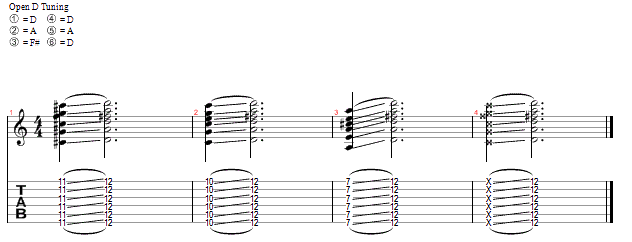Slide Guitar 2
Getting Started
Step 2 - The Slide
The commercially available stainless steel type of slide
is probably best for a beginner - try to find one that fits comfortably without
being too loose.
I would recommend you use your 4th finger (pinky) for the slide as this leaves
the other fingers free to play chords, runs etc.
However if for any reason you can't do this go for another digit (for example
Bonnie Raitt plays great with the slide on her second finger and Mississippi
Fred McDowell used his third finger ).
If you can't find a slide that fits just right consider wrapping a bit of
tissue or similar round your finger before you put the slide on as a slide
that wobbles about will be a hindrance to good technique.
Step 3 - Getting Started
Place the slide directly over the 12th fret covering all 6 strings.
Don't press down but allow the slide to rest on the strings.
The bottom of the slide should line up with and be parallel to the fret.
Now try picking through the strings.
If not all the notes come out or if it sounds rattly put a small amount of
downward pressure on the slide.
Important Note - at no stage should the slide come into contact with
the fret underneath.
If you can't get a clean note without this happening you may have to have your
guitar's action raised.
That old guitar with the really high action that's virtually unplayable could
make a good slide guitar!
Also the strings you use should not be too light - I use and recommend a 12
- 54 gauge set.
Once you have achieved this chord at the 12th fret its time to start tuning
up your ears and listen intently to whether the chord is actually in tune.
One way to do this is to alternate between the open string chord and the chord
at the 12th fret - they should sound the same but an octave apart.
Another method is to move the slide across towards the top string slightly to
leave the bottom string open - by adding this note as a reference point to your
chord it should be possible to hear if your 12th fret chord is in tune.
It is worth spending some time on this stage as ultimately slide playing involves
exact positioning of the slide and being able to slide from anywhere on the
neck to (say for example) the 12th fret chord.
Step 4 - First Slide Exercise
Note I recommend not using a plectrum as right hand damping is a crucial
factor in controlling your sound and this is easier using your fingers.
The following four exercises can be seen in the Tab
Having found that sweet spot for the 12th fret chord try sliding to it from
the 11th fret - a one fret slide.
When you've mastered that try the slide from fret 10 to the 12th - a two fret
slide .
Move on to trying the slide from fret 7 to the 12th - a five fret slide.
Finally try sliding from any random position on the neck to the 12th fret chord
- at this stage you can also practice varying the speed of the slide movement
- a long slow slide from say 7th to 12th sounds quite different from a very
quick slide over the same interval .
Be patient and spend as much time as necessary to master this as accurate positioning
of the slide is the basis of good slide technique.
The tab

© freeguitartuition.com
